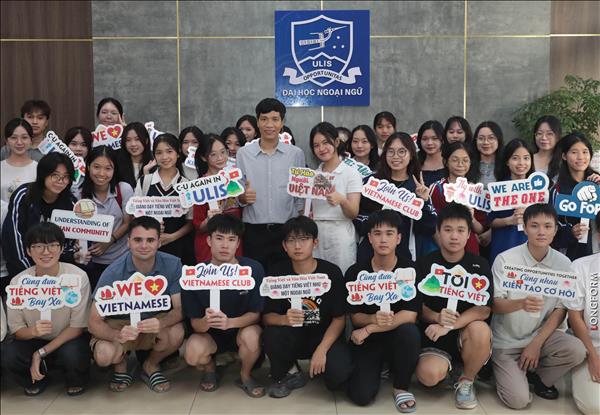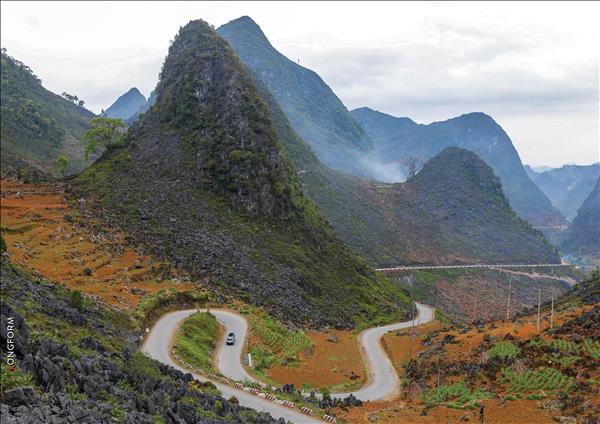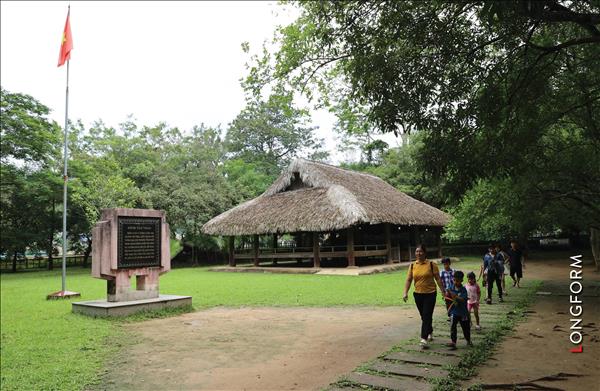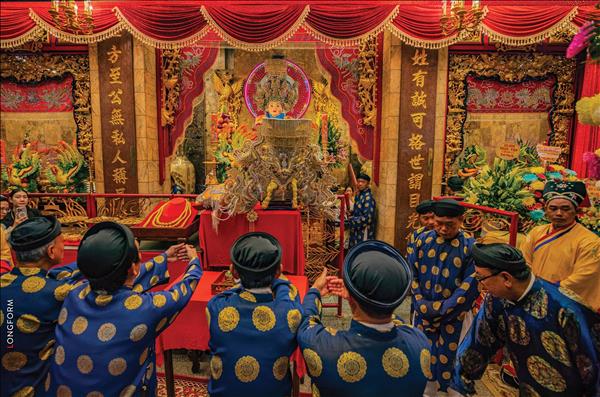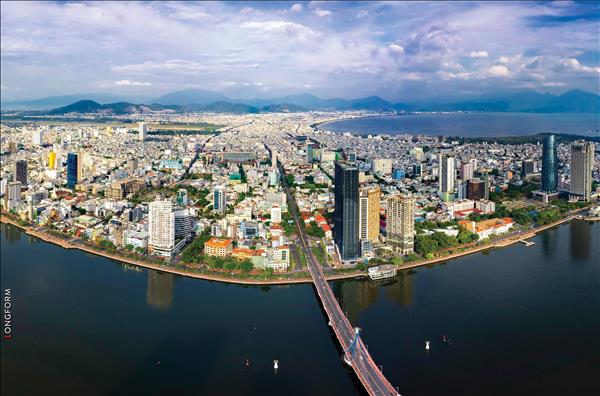The “Heart” of the Sect
The Tay Ninh Cao Dai Temple or the Great Temple - Holy See is the centre of Caodaism. It is one of the most magnificent religious structures in southern Vietnam, 80km north-west of Ho Chi Minh City.
The Holy See was constructed between 1927and 1947 on a total area of 100ha in Hoa Thanh town, Hoa Thanh district, Tay Ninh province. It is a curious and unique building, with a mixture of Asian and European architecture. The whole complex is surrounded by a fence with 12 gates. Seen from afar, the cathedral looks prominent amidst a forest of lush trees.
The Holy See, 93m in length and 22m in width, was designed in the shape of a horse-dragon, heading towards the west, with two horns – one, a drum tower and the other, a bell tower. The architecture of the Holy See reflects the precepts of this religion with a harmonious combination of different architectural styles of Buddhism, Hinduism, Taoism, Confucianism, Christianity and Islamism.
The Holy See resembles a Catholic church, but its systems of 156 great columns decorated with dragons and coated in white, red and blue paint, and roofs were built like those of a Vietnamese communal house and pagoda.
At the top of the main façade, there is a statue of Maitreya Buddha sitting on a lotus tower. There are also two towers of Nghinh Phong Dai and Bat Quai Dai which are typical of Islamism and Taoism, respectively.
The exterior and interior of the Cao Dai Temple are extravagantly decorated, incorporating symbols, abstract designs and images of saints. The interior of the Holy See consists of a collonaded hall called Cuu Trung Dai. Its floor is divided into nine parts, one higher than the others towards the sanctuary.
The domed ceiling in the sanctuary represents a night sky full of stars. Under the dome is a giant star-speckled globe on which is painted the Divine Eye, the official symbol of Caodaism.
Surprisingly, the whole structure was built by local farmers and Caodaism dignitaries who had no construction skills. All stages of construction were done by hand without any blueprints.
For nearly a century, the cathedral has been kept intact, worthy of being called the heart of the “holy land” . Today, it has become not only a place of pilgrimage for Caodaism followers all over the world but also a popular spiritual destination of domestic and foreign tourists.
New Vitality of the Holy Land
Every year, from January 8-15 according to the lunar calendar, pilgrims nationwide flock to the Cao Dai Temple to attend the great ceremony of “Via Duc Chi Ton”, one of the two most important events of Caodaism dignitaries and followers. The other is “Hoi Yen Dieu Tri Cung” to commemorate their Great Mother.
For Caodaism followers, Duc Chi Ton is the God, the Supreme Creator or the Great Father, who created the creatures in the universe and Dieu Tri Kim Mau is their Great Mother.
The ceremony plays an important role in the spiritual life of Caodaism dignitaries, deacons and followers because it shows the distinctive features of Caodaism but also their respect to their Great Father.
Visiting the Cao Dai Temple in TayNinh on the ceremony, pilgrims and tourists have a chance to discover the beauty of its architecture and typical characteristics of Caodaism through solemn rites, such as incense offering, worshiping and praying, and a series of cultural activities, folk games, art performances, martial arts competitions and four sacred animal dances.
In recent years, the living standards of locals, especially Caodaism dignitaries and followers, have much improved. The whole district of Hoa Thanh has now 552 enterprises which are mostly owned by Caodaism followers. These enterprises closely coordinate with the local authority to provide jobs for locals, engaged in patriotic emulation campaigns, charitable activities, poverty reduction efforts, and rural development programmes.
Talking about Caodaism, Monsignor Thuong Tam Thanh, Head of the Sacerdotal Council of the Cao Dai Tay Ninh Church said that the sect comprises many doctrines which are inclined towards the good. Besides implementing the Party’s guidelines and the State’s laws, the Cao Dai churches continually promote unity and mutual support in religious activities. They improve the material and spiritual life of Caodaism dignitaries and followers, contributing to the national construction and defence of the country under the Church’s motto “For the country’s glory and religion’s enlightenment”.
The Tay Ninh Cao Dai Temple or the Great Temple - Holy See is the centre of Caodaism. It is one of the most magnificent religious structures in southern Vietnam, 80km north-west of Ho Chi Minh City.
The Holy See was constructed between 1927and 1947 on a total area of 100ha in Hoa Thanh town, Hoa Thanh district, Tay Ninh province. It is a curious and unique building, with a mixture of Asian and European architecture. The whole complex is surrounded by a fence with 12 gates. Seen from afar, the cathedral looks prominent amidst a forest of lush trees.
|
Caodaism is a Vietnamese religion founded in 1926 in the southern province of Tay Ninh. It is now one of the major religions in Vietnam with millions of followers. Photo: Nguyen Luan/VNP 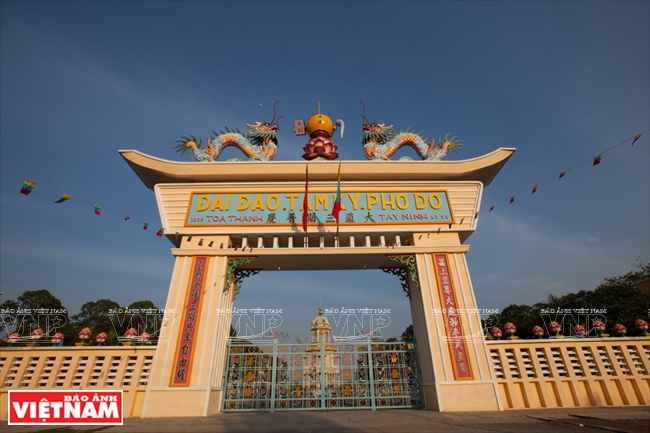 The main entrance to the Tay Ninh Cao Dai Temple. Photo: Nguyen Luan/VNP The unique architecture of roofs shows the mixture of both Vietnamese and Muslim architecture. Photo: Nguyen Luan/VNP 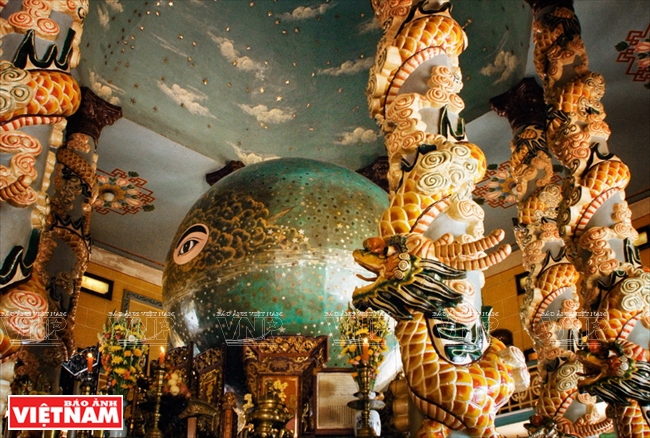 Inside the main hall stands a giant star-speckled globe on which is painted the Divine Eye, the official symbol of Caodaism. Photo: Nguyen Luan/VNP 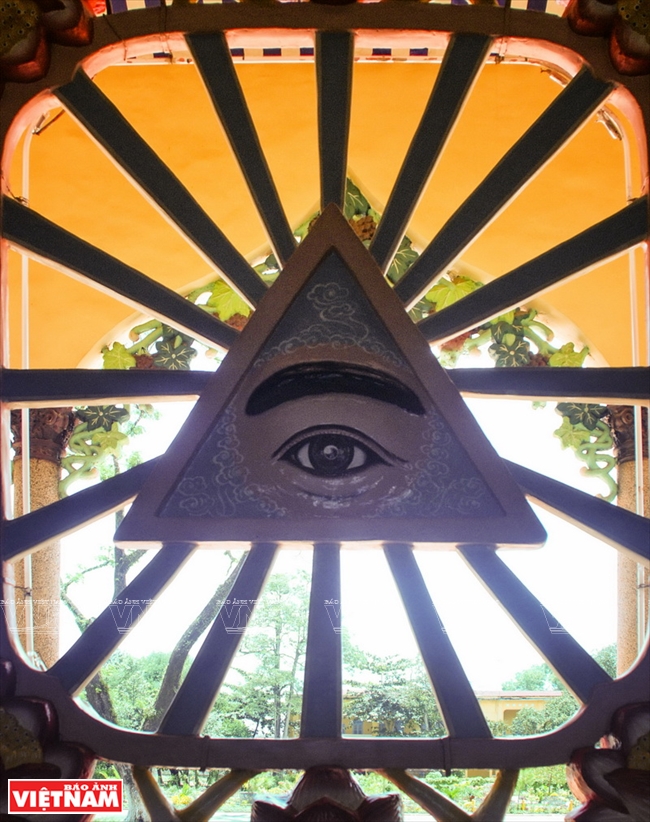 The Devine Eye is worshipped in the house of Caodaism followers. Photo: Nguyen Luan/VNP The Devine Eye is used for decoration on windows in the Tay Ninh Cao Dai Temple. Photo: Nguyen Luan/VNP Caodaism followers attend a ceremony at the Tay Ninh Cao Dai Cathedral Temple. Photo: Nguyen Luan/VNP. |
The Holy See, 93m in length and 22m in width, was designed in the shape of a horse-dragon, heading towards the west, with two horns – one, a drum tower and the other, a bell tower. The architecture of the Holy See reflects the precepts of this religion with a harmonious combination of different architectural styles of Buddhism, Hinduism, Taoism, Confucianism, Christianity and Islamism.
The Holy See resembles a Catholic church, but its systems of 156 great columns decorated with dragons and coated in white, red and blue paint, and roofs were built like those of a Vietnamese communal house and pagoda.
At the top of the main façade, there is a statue of Maitreya Buddha sitting on a lotus tower. There are also two towers of Nghinh Phong Dai and Bat Quai Dai which are typical of Islamism and Taoism, respectively.
The exterior and interior of the Cao Dai Temple are extravagantly decorated, incorporating symbols, abstract designs and images of saints. The interior of the Holy See consists of a collonaded hall called Cuu Trung Dai. Its floor is divided into nine parts, one higher than the others towards the sanctuary.
The domed ceiling in the sanctuary represents a night sky full of stars. Under the dome is a giant star-speckled globe on which is painted the Divine Eye, the official symbol of Caodaism.
Surprisingly, the whole structure was built by local farmers and Caodaism dignitaries who had no construction skills. All stages of construction were done by hand without any blueprints.
For nearly a century, the cathedral has been kept intact, worthy of being called the heart of the “holy land” . Today, it has become not only a place of pilgrimage for Caodaism followers all over the world but also a popular spiritual destination of domestic and foreign tourists.
New Vitality of the Holy Land
Every year, from January 8-15 according to the lunar calendar, pilgrims nationwide flock to the Cao Dai Temple to attend the great ceremony of “Via Duc Chi Ton”, one of the two most important events of Caodaism dignitaries and followers. The other is “Hoi Yen Dieu Tri Cung” to commemorate their Great Mother.
For Caodaism followers, Duc Chi Ton is the God, the Supreme Creator or the Great Father, who created the creatures in the universe and Dieu Tri Kim Mau is their Great Mother.
The ceremony plays an important role in the spiritual life of Caodaism dignitaries, deacons and followers because it shows the distinctive features of Caodaism but also their respect to their Great Father.
Visiting the Cao Dai Temple in TayNinh on the ceremony, pilgrims and tourists have a chance to discover the beauty of its architecture and typical characteristics of Caodaism through solemn rites, such as incense offering, worshiping and praying, and a series of cultural activities, folk games, art performances, martial arts competitions and four sacred animal dances.
|
Dance performances in front of the Tay Ninh Cao Dai Temple. Photo: Nguyen Luan/VNP Caodaism followers attend a ceremony at the Tay Ninh Cao Dai Cathedral Temple. Photo: Nguyen Luan/VNP Three generations in a family go to attend the great ceremony of “Via Duc Chi Ton”. Photo: Nguyen Luan/VNP Traditional musical instruments of the Khmer who follow Caodaism attracts a large number of tourists and Caodaism followers. Photo: Nguyen Luan/VNP Caodaism followers jubilantly celebrate the great ceremony of “Via Duc Chi Ton” held on January 8, 2017, according to the lunar calendar. Photo: Nguyen Luan/VNP Children whose parents are Caodaism followers are taught virtues and morals of the religion before officially becoming members at the age of 18. Photo: Nguyen Luan/VNP |
In recent years, the living standards of locals, especially Caodaism dignitaries and followers, have much improved. The whole district of Hoa Thanh has now 552 enterprises which are mostly owned by Caodaism followers. These enterprises closely coordinate with the local authority to provide jobs for locals, engaged in patriotic emulation campaigns, charitable activities, poverty reduction efforts, and rural development programmes.
| Cao Dai Temple on the ceremonies of “Via duc chi ton” and “hoi yen dieu tri cung”, pilgrims and tourists have a chance to discover the beauty of its architecture and typical characteristics of Caodaism through solemn rites, such as incense offering, worshiping and praying, and a series of cultural activities, folk games, art performances, martial arts competitions and four sacred animal dances. |
Story: Nguyen Vu Thanh Dat - Photos: Nguyen Luan


